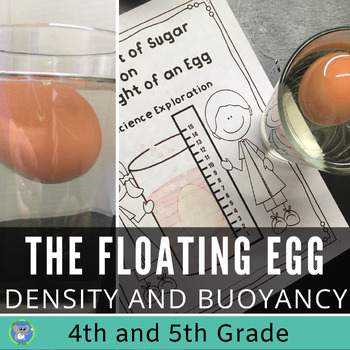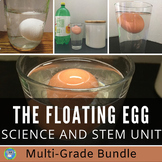Sink and Float Science And STEM | The Floating Egg | Easter and Spring Activity
- PDF
Also included in
- Bundle and SAVE on this collection of our favorite science and STEM holiday activities. You will get 7 project-based units that are popular for Halloween, Thanksgiving, Christmas, Valentine's, Saint Patrick's Day, and Easter. They meet the standards and can be used anytime, too!Each Unit IncludesAnPrice $32.92Original Price $41.15Save $8.23
- Discover solutions, density, and buoyancy with an engaging project based learning unit. We have taken the classic egg float lab up a notch. Bundle and Save with both differentiated explorations. A wonderful experiment for Easter and springtime. Integrating soda improves critical thinking skillsPrice $10.40Original Price $13.00Save $2.60
Description
In this project based learning unit, students will discover solutions, density, buoyancy, and buoyant force in 3 hands-on explorations. Includes an investigation, exploration activity, and STEM Challenge. A teacher guide and student worksheets will take you step-by-step. Great for Springtime, Easter, or a Matter and Its Interactions unit. Definitely Memorable!
This hands-on exploration and teacher guide includes:
- Correlation to the NGSS
- Teacher Background Information and Tips
- Science Investigation Journal: The Effect of Sugar on the Buoyancy of an Egg: Soda Science Exploration
- Further Exploration Activity: Comparing Regular and Diet Soda on the Height an Egg Floats.
- STEM Challenge, where students create a solution to cause an egg to float to specific criteria.
- Why do things Float and Sink? Reading Passage and Questions
- Vocabulary Interactive Notebook
- Answer Keys and Rubrics
- Examples of STEM Challenge Projects
Students will follow the scientific method to gain an understanding of solutions, density, and buoyancy using soda, sugar, and eggs. Students will use their evidence to explain how the density of the solution affects the egg. They will explore further with diet soda. The STEM challenge will enable students to participate in a chemistry STEM challenge, creating a solution to meet specific criteria. Students will need to think analytically and use higher-order thinking skills to take the lead in their learning. This unit expands from the 2nd/3rd grade version to include 4 tests, increased writing, and expanded reading passage.
By the end of the activity, students can answer and explain the question:
Does the amount of sugar in soda pop affect the height an egg floats?
Teachers will like the ease of use, background information, and easy-to-find materials. Teachers enjoy observing their students take the lead in their learning. It is memorable for both the teacher and students. You can expand the lesson further with the included reading material and vocabulary pages. We did the lesson planning, now you can set up and enjoy with your students.
This exploration really takes the classic egg float lab up a notch.
Supplies Needed:
eggs, sugar, diet soda, regular soda, spoons, bowls, graduated cylinders, glass jars, ruler, scissors, various liquids for the STEM challenge (water, juice, etc.), various salts and sugars for the STEM challenge.
The activities meet the following Next Generation Science Standards:
- 3rd-5th Grade Science and Engineering Practices
- 5th Grade Structures and Properties of Matter: 5-PS1-3
Great for the classroom, science clubs, STEM Clubs, Scout Groups, Science Camps, homeschool, science fairs, and just for fun.
This investigation is part of a series. This is the 4th/5th-grade version. Please click each grade level version below to see more details.
Science And STEM Exploration: The Floating Egg Density And Buoyancy Lab, Gr 2/3
Save 20% on each resource with the Bundle. Great for differentiation and multi-grade teachers.
Science And STEM Bundle Exploration | The Floating Egg Density And Buoyancy Lab
You might also like
Cartesian Diver STEM: Density, Sinking, And Floating Exploration
Properties Of Matter Exploration: An Egg-cellent Exploration
Remember, leaving feedback earns you points toward FREE TPT purchases. We love hearing how the investigation went.
Also, follow us and be notified when new explorations are uploaded and deals.
Please contact us with any questions! We are here to help.
Yours in Science,
Kimberly Scott
All parts are copyrighted. Please see the Terms of Use in the download.







